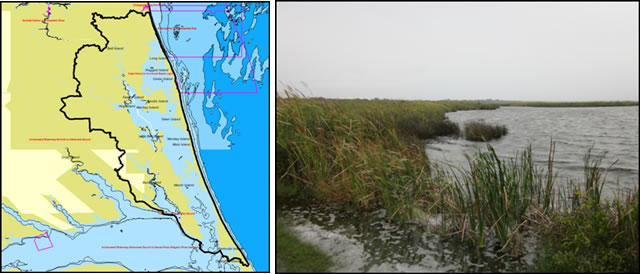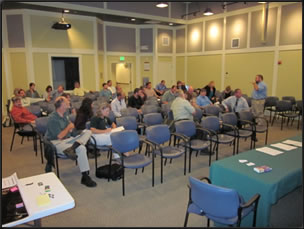Objective Setting: A Currituck Sound Case Study
Currituck Sound is a large estuary located in northeastern North Carolina and southeastern Virginia and is part of the Albemarle-Pamlico National Estuary. Thin barrier islands separate the Sound from the Atlantic Ocean, and the system receives saline inputs primarily through the southern entrance to the Sound. Historical observations identify Currituck Sound as having high water quality and significant submerged and emergent aquatic vegetation coverage which provided for a flourishing bird and fish community. In the last 50-100 years, significant changes have taken place in the Sound, and the health of the ecosystem has declined considerably. To counteract this trend, the North Carolina Department of Environmental and Natural Resources (DENR) has partnered with the U.S. Army Corps of Engineers (USACE) Wilmington District to identify potential restoration actions within Currituck Sound.

"A clear definition of objectives and constraints is essential to the success of the planning process" (USACE 2000, ER-1105-2-100, Planning Guidance Notebook). Proper articulation of a complete and clear set of objectives paves the way for metric and model development, alternative formulation, and plan comparison. Although the importance of objectives is well-acknowledged, coming to agreement on a set of objectives is challenging for large-scale, multi-faceted ecosystem restoration projects. A number of techniques were used to guide objective setting for the Currituck Sound estuary restoration project, including:
- Structured objective setting following the four-step process of: (1) write down the concerns you want to address, (2) convert the general concerns into succinct objectives, (3) structure objectives, and (4) clarify what is meant by each objective. Generally speaking, the project team iterated through the four-step process multiple times with each successive application involving a larger audience (e.g., USACE planning team, entire USACE team, combined USACE-DENR team, resource agencies and pertinent parties, and finally the general public). In each round of application, objectives were added, refined, and greater buy-in was obtained.
- Application of existing assessments: Currituck Sound is a well-studied ecosystem with a number of historical assessments of its environmental condition. Assessments came from peer-reviewed literature, coastal planning and conservation prioritization efforts by the State of North Carolina, and well-documented, large-scale declines of coastal wetlands and seagrass communities in the region (e.g., http://web.vims.edu/bio/sav).
- Use of conceptual models: Given the complex interactions among ecosystem processes in Currituck Sound, a set of conceptual models was concurrently developed during the objective setting process to assist the project team with appropriately understanding system processes, diagnosing underlying stressors, guiding numerical model development, and facilitating communication among team members.
- Referenced-based approaches: As part of early project planning, the USACE team worked with the State and an interagency group to identify an appropriate reference condition as the target for restoration actions. This reference condition drew heavily from a historical assessment of the Sound (c. 1965). Given social constraints and the uniqueness of Currituck Sound’s wind-driven estuarine community, the team agreed that the objectives should center on restoring an estuary system which is disconnected from the ocean during all but large storm events.
 From this process, three project goals were identified for Currituck Sound restoration (listed below). Goal 1 emphasizes the restoration of ecosystem structure, function, and dynamic processes and serves as the impetus for plan formulation. Goal 2 describes secondary benefits offered by the project which are not the focus of plan formulation but do provide ancillary benefits of particular note (i.e., those associated with USACE “accounts” for National Economic Development, Regional Economic Development, and Other Social Effects). Goal 3 highlights the aims of the project team in carrying out the restoration process. Although Goal 1 is the primary objective and source of National Ecosystem Restoration (NER) benefits, Goals 2 and 3 describe elements of the project that help the USACE team communicate with the USACE chain-of-command, cost-share sponsor, external agencies, and other stakeholder groups. Each goal was decomposed into objectives and sub-objectives in order to clarify the direction and purpose of the project to the greatest extent possible, resulting in 8 objectives and 26 sub-objectives.
From this process, three project goals were identified for Currituck Sound restoration (listed below). Goal 1 emphasizes the restoration of ecosystem structure, function, and dynamic processes and serves as the impetus for plan formulation. Goal 2 describes secondary benefits offered by the project which are not the focus of plan formulation but do provide ancillary benefits of particular note (i.e., those associated with USACE “accounts” for National Economic Development, Regional Economic Development, and Other Social Effects). Goal 3 highlights the aims of the project team in carrying out the restoration process. Although Goal 1 is the primary objective and source of National Ecosystem Restoration (NER) benefits, Goals 2 and 3 describe elements of the project that help the USACE team communicate with the USACE chain-of-command, cost-share sponsor, external agencies, and other stakeholder groups. Each goal was decomposed into objectives and sub-objectives in order to clarify the direction and purpose of the project to the greatest extent possible, resulting in 8 objectives and 26 sub-objectives.
- Goal 1: Restore significant ecosystem structure, function, and dynamic processes by providing a mosaic of interconnected ecosystem types contributing to a resilient estuarine system supporting a diverse faunal assemblage.
- Goal 2: Protect existing economic, social, and cultural resources.
- Goal 3: Implement a collaborative, comprehensive, system-wide study.
EBA Resources
|
 |


